
Green Lawn Cemetery is an active historic private rural cemetery located in Columbus, Ohio, in the United States. Organized in 1848 and opened in 1849, the cemetery was the city's premier burying ground in the 1800s and beyond. An American Civil War memorial was erected there in 1891, and chapel constructed in 1902. With 360 acres (150 ha), it is Ohio's second-largest cemetery.

Battelle Hall is a 6,864 seat multi-purpose exhibit hall located in Columbus, Ohio, part of the Greater Columbus Convention Center. It opened as the Ohio Center on September 10, 1980, and although sometimes considered a white elephant because of its small size and seating capacity, it has been used for a variety of events, including concerts, trade shows, and sporting events such as the 1993 and 1994 Mid-American Conference men's basketball tournaments. The exhibit hall was also the home of professional wrestling cards from the early 1980s to mid-1990s with monthly visits from the WWE and the occasional WCW event. The hall totals 90,000 square feet (8,400 m2) of exhibit space - 65,000 on the main floor and 25,000 on the balcony, and can be divisible into two halls.

Hilltop is one of the largest neighborhoods in Columbus, Ohio, located west of Franklinton and Downtown. The Greater Hilltop area contains newer and historic neighborhoods, schools, various stores, industrial areas, and recreational facilities. The development pattern is considered a distinct suburb. The majority of the area is predominantly single family residential.

Franklinton is a neighborhood in Columbus, Ohio, just west of its downtown. Settled in 1797, Franklinton is the first American settlement in Franklin County, and was the county seat until 1824. As the city of Columbus grew, the city annexed and incorporated the existing settlement in 1859. Franklinton is bordered by the Scioto River on the north and east, Harmon Avenue on the east, Stimmel Road and Greenlawn Avenue on the south, and Interstate 70 on the west. Its main thoroughfare is West Broad Street, one of the city's two main roads.
Murray Hill is a neighborhood on the west side of Columbus, Ohio. It is part of the Lincoln Village subdivision and is colloquially known as Lincoln Village. It is bounded by West Broad Street on the north, Sullivant Avenue on the south, South Grener Avenue on the east, and Redmond and Hiler Roads on the west. It is in Prairie Township, and the ZIP Code 43228.
West Columbus, sometimes referred to as westside or the West Side, is a neighborhood in Columbus, Ohio, United States. Unlike other Columbus neighborhoods, it is a broad geographical term used by locals rather than a subdivision or suburb. West Columbus is defined as the entire southwest side of Columbus, bordered on the north by interstates 70 and 670, within Interstate 71 on the east, and on the south and west by the city limits that reach several miles to the outside of the I-270 outerbelt. It covers the ZIP Codes 43223, 43204, 43228, and 43222.
Columbus, the state capital and Ohio's largest city, has numerous neighborhoods within its city limits. Neighborhood names and boundaries are not officially defined. They may vary or change from time to time due to demographic and economic variables.
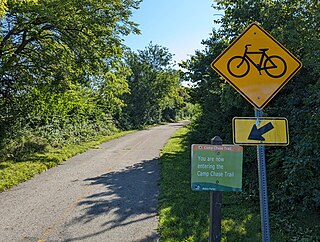
The Camp Chase Trail is a paved multi-use trail in Madison and Franklin counties in the U.S. state of Ohio. It serves as the Southwest Columbus segment of the 326-mile (525 km) Ohio to Erie Trail. The entire length of the Camp Chase Trail is part of the Great American Rail-Trail, U.S. Bicycle Route 21 and U.S. Bicycle Route 50.

Lucas Sullivant, was the founder of Franklinton, Ohio, the first American settlement near the Scioto River in central Ohio.
Columbus, the capital city of Ohio, was founded on the east bank of the Scioto River in 1812. The city was founded as its capitol, beside the town of Franklinton, since incorporated into Columbus. The city's early history was gradual, as residents dealt with flooding and cholera epidemics, and the city had few direct connections to other cities. This led creation of a feeder canal, and later, freight and passenger railroads. The city became known for its industry and commercial businesses into the 20th century, though it experienced a lull in development in the late 20th century. In the 21st century, Columbus has been increasingly revitalized, led by parks projects, new developments, and efforts to beautify individual neighborhoods.

The Discovery Bridge, commonly known as the Broad Street Bridge, is a bridge in Columbus, Ohio, United States, carrying Broad Street over the Scioto River and connecting Downtown Columbus to Franklinton. The bridge was named in reference to Christopher Columbus's "discovery" of the Americas; the bridge includes artistic bronze medallions featuring symbols of the explorer.
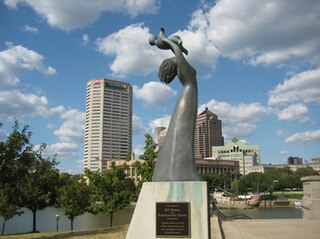
Celebration of Life, also known as the Arthur Boke/Sarah Sullivan statue, is a 2004 bronze sculpture by Alfred Tibor, installed near Franklinton's Genoa Park, in Columbus, Ohio, United States. The artwork depicts a woman holding a baby above her head, and commemorates Arthur Boke, the first known black child born in Franklinton, and Sarah Sullivant, the wife of Lucas Sullivant. The Sullivants, a white couple, raised Boke as their own child.
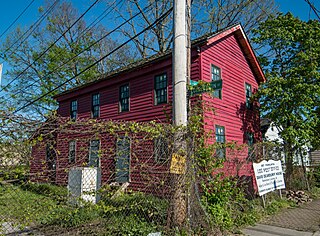
The Franklinton Post Office is a historic building in the Franklinton neighborhood of Columbus, Ohio. It was listed on the National Register of Historic Places in 1973. Also known as the David Deardurff House, it was built of hand-hewed logs by Deardurff in 1807. The two-story house sits on a limestone foundation. It is the oldest building in Columbus still on its original foundation. The building is on Gift Street, an area owned by Franklinton founder Lucas Sullivant, given to early settlers. The first post office in Franklinton was established here.
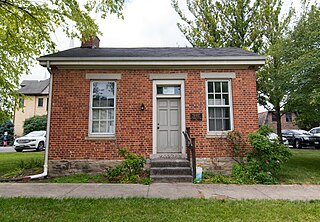
The Sullivant Land Office is a historic building in the East Franklinton neighborhood of Columbus, Ohio. It was listed on the National Register of Historic Places in 1973 and the Columbus Register of Historic Properties, along with the Gen. William Henry Harrison Headquarters, in 1985. The small brick building was built c. 1822. Its original use was as a single-room real estate office, although it was later expanded. At the time of construction, Lucas Sullivant was selling and giving away pieces of land, and Franklinton became the county seat of Franklin County. The building is the only remaining structure associated with Lucas Sullivant in the Franklinton area. In the early 1980s, the Columbus Recreation and Parks Department moved the building from its original location at 714 W. Gay St. to 13 N Gift St., behind the William Henry Harrison house. The move was prompted because the building was endangered in its original location, with vandalism, deterioration, and plans to create a parking lot for a car dealership on the site.

The Columbus Historical Society (CHS) is the historical society for Columbus, Ohio, chronicling the city's history. The society office and museum building is located in the Franklinton neighborhood. In 2020, the Columbus Historical Society aims to raise funds to purchase Engine House No. 6 for its first permanent home.

The Great Flood of 1913 severely affected Columbus, Ohio. The area most affected was Franklinton, also known as the Bottoms, for its low elevation near the Scioto River. Among many infrastructure projects, a 7.2-mile floodwall was built from 1993 to 2004 to protect most of Franklinton from flooding.

The Museum of Catholic Art and History, formerly known as the Jubilee Museum and Catholic Cultural Center, is a museum of Catholic relics and art in Columbus, Ohio. The museum is located on Broad Street in Downtown Columbus, where it reopened in late 2021. The museum was formerly located at the schoolhouse of the Holy Family Church in the city's Franklinton neighborhood, from 1998 to 2019.

The 1840 Franklin County Courthouse was the first permanent courthouse of Franklin County, Ohio in the United States. The building, located in the county seat of Columbus, stood from 1840 to 1884. The building was replaced with another county courthouse in 1887, and after its demise, that courthouse was replaced with Dorrian Commons Park, open from 1976 to 2018; the courthouse moved to a new building nearby. The site is now planned to host the Franklin County Municipal Court.
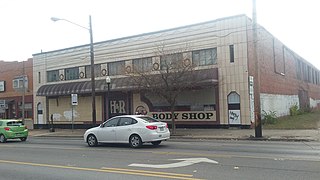
The McClure-Nesbitt Motor Company is a historic automobile dealership in the South of Main neighborhood of Columbus, Ohio. It was listed on the Columbus Register of Historic Properties in 2017.



















